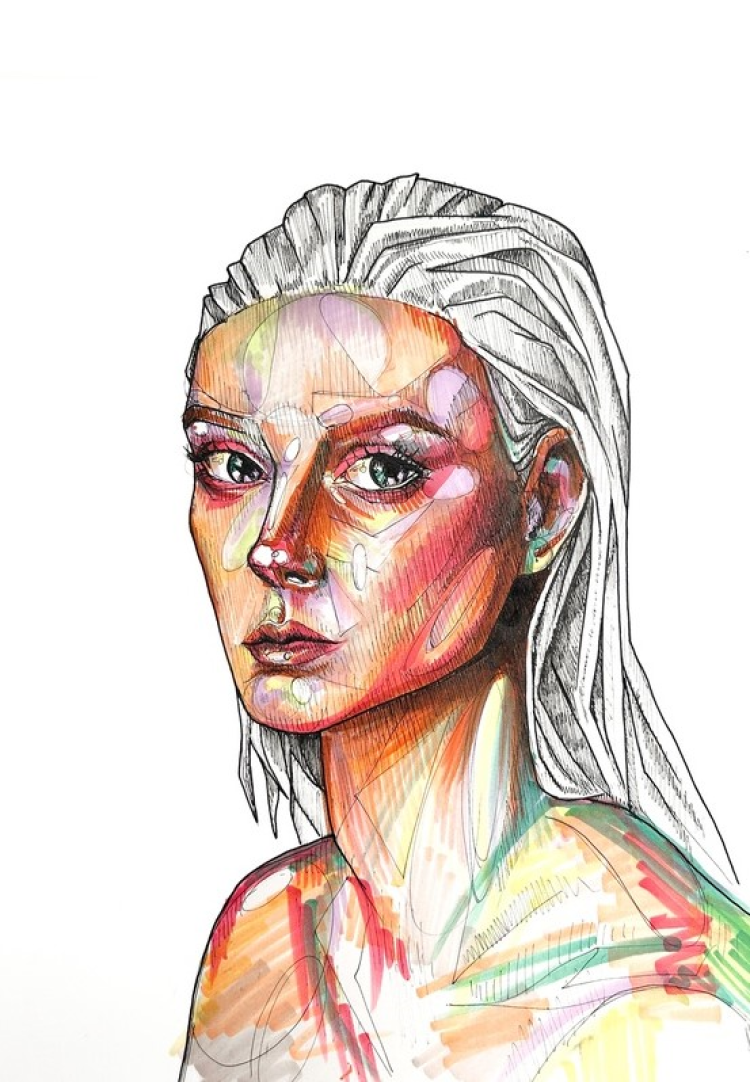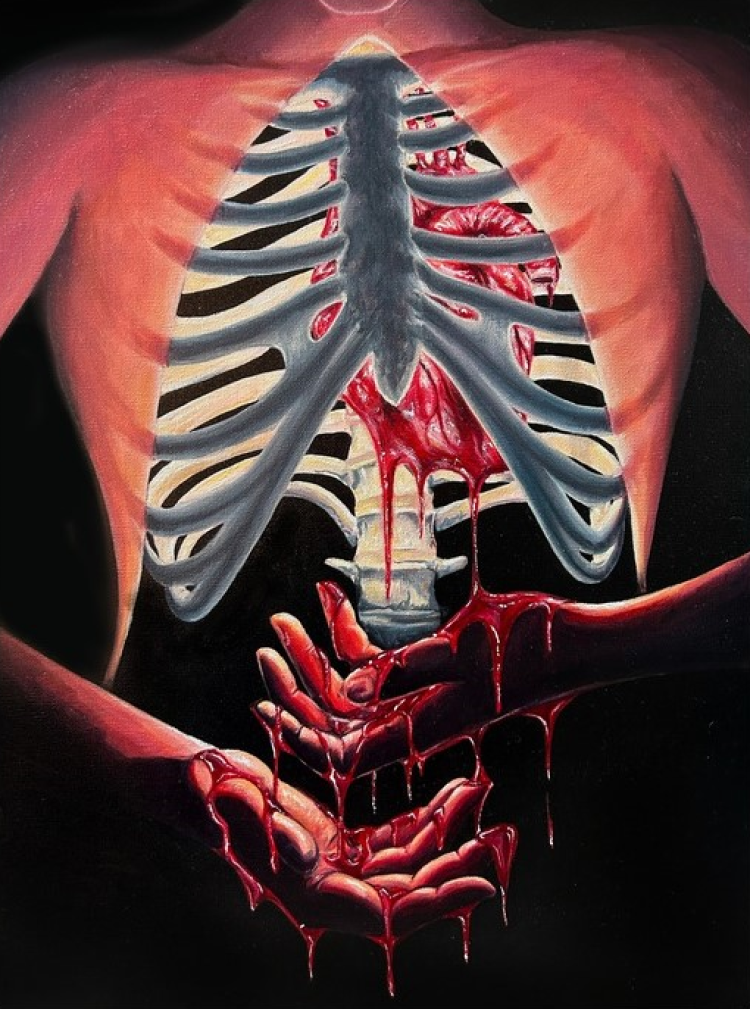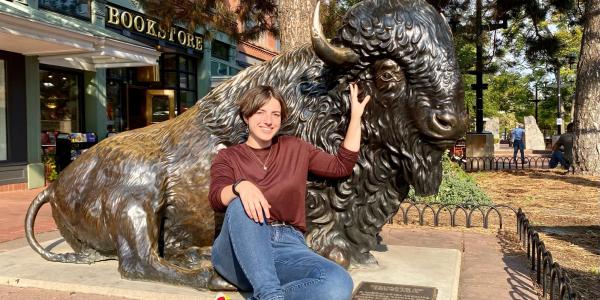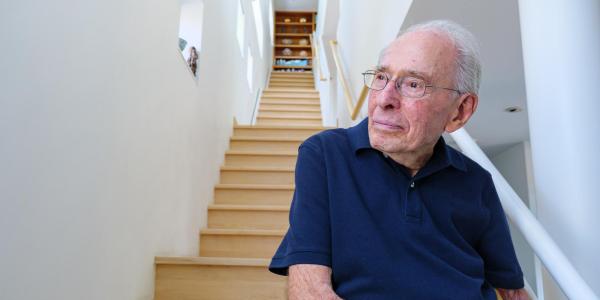Neuroscience and art practices major Rachel Suter joins The Ampersand podcast to discuss asking ‘Why not?’ and stepping into the unknown
Rachel Suter steps to the precipice and looks over the edge. Below her, a glowing aqua pool that’s 30 feet down. As many times as she’s pushed off the edge, she still feels a little zing.
She dives into a pool at the newly renovated Casa Bonita restaurant in Denver. The way the water blends in and out of sapphire blue reminds her of her newest painting, exploring neurological degeneration, which reminds her, in turn, to finish her neuroscience homework before she can get to her next student body government meeting.
Amid the noise of the restaurant, the sweet fried scent of sopapillas, her fellow performer in a gorilla costume, she takes a breath, counts back from three and soars.
Rachel is a lot of things, not just a woman who flies. She crafts visual art based on scientific systems and principles she explores in her neuroscience coursework. She guides the College of Arts and Sciences student body as vice president. She's a model, she dives, she approaches new opportunities asking, “Why not?”

At the top of the page: Rachel Suter works on her art. Photo by Kylie Clarke. Above: "Vibrant" by Rachel Suter.
She recently joined host Erika Randall, associate dean for student success in the College of Arts and Sciences, on "The Ampersand,” the college podcast. Randall—who also is a dancer, professor, mother, filmmaker and writer—joins guests in exploring stories about “ANDing” as a “full sensory verb” that describes experience and possibility.
Their free-wheeling discussion addressed confronting fear, the mechanics of diving and oatmeal baths, among many other topics.
Suter: When I was younger, I always wanted to dive, but I couldn't because I have pretty bad eczema. I was a competitive gymnast, and then, following that, I did competitive dance. So, you know, just parallel sports, almost. And then senior year of high school, I just kind of decided, like, end of COVID, I'm really bored. I'm just going to give it a try, you know, just for fun?
Randall: Screw the eczema. There's oatmeal baths for that.
Suter: So true.
Randall: Yeah. (laughs) My kiddo has eczema. OK, so you're going to try it.
Suter: Yes.
Randall: You're going to go in.
Suter: Mm-hmm, and like, in the past, I had gone cliff-diving with friends just at lakes and vacations and…
Randall: See, again, you say that so casually: ‘In the past, I'd gone cliff diving.’ There isn't a world where I walk up to the edge of something and jump off of it. There was no fear for you there.
Suter: Yeah, I have two brothers, and they're the type that they see a cliff, and they will jump off of it. I just don't want to be left out of that, you know? And then, just having the gymnastics background, and the worst that could happen in gymnastics is you fall on a really hard surface, and that's really scary. But with diving, it's like you're falling on water, so there's only so much bad that could happen. And the hurt, it's going to hurt, but it won't last that long. And cliff diving, I don't go from too high, so the risk is minimal.
But I think the most important thing is when I do the one, two, three count, I have to trust myself that I'm going to go for it, you know? And it's like…
Randall: Is that what you say literally every time you get to the edge?
Suter: Yep.
Randall: OK, well, I want to hear it. Walk me through. Put me in your body.
Suter: Oh, man. Yeah, I think it's just a quick visualization of the dive. I mean, if it's a forward dive or a backflip, not too much. It's pretty simple. But if it's more of like a twisty dive, just stepping through what my arms are going to do and whatnot, and then standing on the edge, marking my place in the water. And if it's a smaller pool, just making a plan for what I'm going to do underwater because you can flip out of it either way.
So, choosing space and also choosing if I'm going to flip out of it right away or if it's safe enough to go and bounce off the bottom almost, which I can do at pools like Casa Bonita, but I can't at cliff diving spots like Paradise Cove. So, yeah, just making a plan, going through it, and then just counting off, like one, two, three, go, and just trusting that on three, I would go.
Randall: Life lessons with Rachel Suter, making a plan, trusting it. One, two, three, go. OK, so is that what took you to interview at Casa Bonita, that just one, two, three, go, let's do this?
Suter: Yeah. I mean, I didn't expect to get the job. So, it was more of a, ‘I might as well.’ That would just be so cool. I have a dance background, so I have the performance aspect.
Randall: And had you been there as a kiddo if you're from the Springs?
Suter: No, I'd heard all about it, but I had never actually been.
Randall: OK, so you heard the lore.
Suter: Yes.
Randall: But you had never been and had the terrible taco salad with the Pepto-Bismol chaser.
Suter: Never had it.
Randall: Never had it. And did you hear about how there used to be the electrical room at the bottom of the dive pool?
Suter: They fixed that.
Randall: OK. (laughs)
Suter: Yeah, so I ended up going because just so many of my friends and family had just been, like, oh, you have to. You dive. You just have to do it. I was like, OK.
Randall: So, when we think about this pattern of success, this way that you set up the visualization, all of the things, does this show up for you in other ways in your life? Because on top of being now this enigmatic Casa Bonita diver, you are also a neuroscience student. You're also a visual artist. You are on student government.
You are a leader in your community. You are one of the kindest humans I know. And, and, and, and then you tell me you model, and I just couldn't even put that part into the Rachel egg. Talk to me about if that method for getting to the edge and looking over, does that serve you in other spaces?
Suter: Yeah, it's more of like, I'm young and I know that this is the time in my life where I will most be able to try new things and pursue different things and have no consequences if it doesn't work out.
Randall: OK, wait a second. You really just have that freedom in your mind, like this is the time when I'm young. How good were your parents, or did they just never know if you were home?
Suter: (laughs) No, my parents are amazing. They’re very adventurous and pushed us, my brothers and I, all to try new things and just be confident in what we're doing.
Randall: Did they throw you into the pool when you were a little kid with all your clothes on and see if you would drown?
Suter: I don't know, but they might have.

"Too Much to Hold" by Rachel Suter
Randall: They might. They were that parenting book.
Suter: Yes. And if we had a little interest in something, they would help us and support us and provide the materials to do those, which I really appreciate and I know not everybody has. So, I think that definitely has allowed me to become a better artist and interested in sciences because they allowed me to have those resources as a kid. And so now that I have the freedom of my own time, I'm able to explore those.
Randall: Were science and art always married for you? Because when I look at your art, first of all, it's astounding to me.
Suter: Thank you.
Randall: I had seen the original piece that you shared with me with, this gesture of hands under the sternum and the heart dripping out of your cage. And then there were other things that showed up in your art, this perspective, detail, that kind of pencil sketch fury. Like, there's a quickness that also maybe is not showing how much time it takes. I mean, it's a lot of time.
Suter: Yes, quite. And a project will take probably 15 more hours. It really depends. But the more time-consuming part is the research and development portion.
Randall: Yes, and you can see that the science is in it. And the research is in the science.
Suter: Yeah, because a lot of my art does deal with scientific topics. A lot of times, I just don't even know what I want to do, and it starts with the research and just taking notes and deciding on a topic that I like and I'm passionate about. And so, I'll continue doing research and start with little one-inch by one-inch thumbnail sketches of little ideas I could do.
Randall: Kind of storyboarding?
Suter: Yes, so it starts with just a lot of research and then thumbnail sketches. And then it almost becomes a conversation on the page of, oh, I like this idea, but not this. So, it's a way to have a conversation with myself because I never know what it's going to be when I first start. And it goes through so many stages. And sometimes what I end up with is not even on the same topic as what I began with.
Click the button below to hear the entire episode.
Did you enjoy this article? Subcribe to our newsletter. Passionate about arts and sciences? Show your support.



